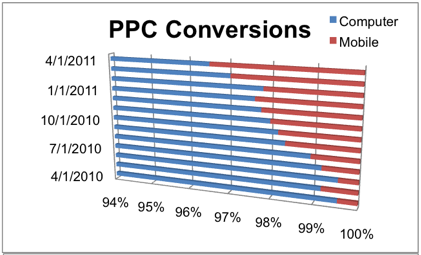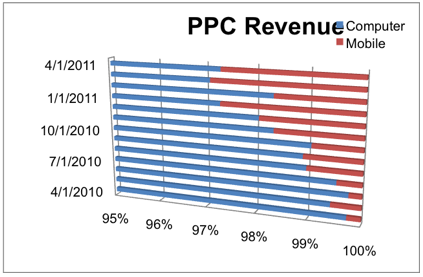“Mobile” and “social” have received a lot of hype over the past few years. To a large extent that hype has been warranted. Sales of smart phones are setting records, and according to Alexa — the web-traffic-ranking firm — socially driven websites account for five of the ten most popular.
For online merchants, however, the hype from mobile and social has resulted in one big collective yawn. Many merchants who raced to build their mobile sites in 2010 generate a very small percentage of their revenue through that source. In addition, many merchants who have successfully collected thousands of Fans on Facebook and followers on Twitter generate only a very small percentage of their revenue from those sources.
Mobile Is Starting to Produce
Why, then, do online merchants continue to invest in mobile and social? Perhaps they believe there is a light at the end of the tunnel, and they want to get there before their competitors do. While social still needs some time to evolve before becoming a high return-on-investment channel for most online retailers, mobile is really starting to perform.
Looking at the Data
The following data from one traditional online retailer reflects trends that we’ve seen across the board with hundreds of retailers whose campaigns we manage.
Recent data on mobile pay-per-click advertising.
In this case, the retailer saw a 910 percent increase in the percentage of clicks that come from mobile devices — versus traditional computers — in one year of advertising through Google AdWords. The retailer also saw a 661 percent increase in mobile’s share of pay-per-click conversions, and a 918 percent increase in mobile’s share of PPC revenue.
This online retailer is not unusual. We surveyed many of our clients — including “Internet Retailer 500” merchants — and mobile’s share of clicks, conversions, and revenue is rising across the board. The overall percentage of PPC that mobile accounts for is still relatively small, but it is growing quickly, and these shoppers are buying.
The graphs below show trends over the last year, as mobile’s share of PPC has increased.
Graph comparing PPC clicks on "mobile" versus "desktop" between April 2010 and April 2011.
As shown in the graph above, mobile received less than 0.5 percent of all PPC clicks in April 2010. By April 2011, the mobile market was garnering around 3.5 percent of all PPC clicks.
Graph comparing PPC conversions on mobile versus desktop computers between April 2010 and April 2011.
The graph above shows that mobile PPC conversions were around 0.5 percent in April 2010. That mobile figure grew to roughly 3.5 percent of all PPC conversions by April 2011.
Graph comparing PPC revenue from mobile versus desktop computers between April 2010 and April 2011.
The graph above shows that mobile PPC revenue increased from around 0.3 percent of total PPC revenue in April 2010, to around 2.8 percent by April 2011.
What Every Advertiser Should Know
By default, your PPC campaigns are already syndicated through mobile devices. You can understand the impact mobile is having on the profitability of your PPC campaigns by running reports in the “Campaigns” tab within AdWords. Look at your data over time, for each individual campaign, to try to spot long-term trends.
If your return on investment is low on ads that are served through mobile devices, consider disabling syndication to mobile temporarily. If your return on investment is high, however, try to scale those profits even further.
5 Ways to Improve Mobile Performance
Here are five things, below, you can do to improve your mobile PPC performance.
-
Build campaigns devoted specifically to mobile. Identify campaigns where the mobile segment is performing well, and use that data to build a new campaign that is completely focused on mobile. This will allow you to experiment with larger budgets, ad copy, landing pages, and bidding strategies catered specifically to mobile shoppers.
-
Utilize Google AdWords Click-to-call. Our clients have had tremendous success with “Click-to-call.” This setting in AdWords allows your ads to generate phone calls instead of clicks when your ad appears on a mobile device. This feature is especially useful if you do not have a mobile site, or if your shoppers would be more inclined to speak with a live sales person while they are mobile.
-
Customize your ad copy to specific devices. Google has a feature in beta that enables you to dynamically insert the name of the device being used by searches in your ad copy (similar to dynamic keyword insertion). This is a great way to tell an iPhone user, for example, that your site is iPhone friendly, to increase click-through rates.
-
Create a mobile site. If your site attracts an increasing number of mobile shoppers in general, and your mobile conversion rate significantly underperforms your main website, consider building a mobile version of your website.
To be sure, not every online business should spend the time and dollars to build a mobile version of its site, at least not yet. Mobile commerce is young, and if a very small percentage of your shoppers come to your site through a mobile device, you may want to wait until mobile site technology becomes better or cheaper.
-
Turn off mobile-ad syndication on poorly performing campaigns. By default, your Google ads will be syndicated to mobile devices. As suggested above, generate reports through AdWords that allow you to assess the performance of your ads when they appear on mobile devices. On campaigns where performance is poor, change your mobile settings.
Conclusion
The data we’ve analyzed suggests that mobile users are starting to use their phones in similar ways to how they use their computers. They are shopping online, clicking on PPC ads, and making purchases from their mobile devices. While online retailers who ignore mobile may be wasting pay-per-click dollars on poorly converting traffic, those retailers who have embraced mobile by testing various PPC techniques and campaign settings to optimize its performance are starting to see results.
As mobile devices become more popular — and faster — more online shopping will be performed on mobile devices. There is no magic bullet for harnessing the profitability of mobile PPC, but this is a good time to begin allocating more of your PPC budget to that source.




